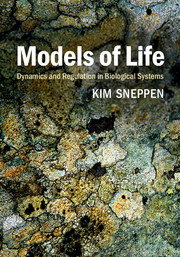Book contents
- Frontmatter
- Contents
- Preface
- 1 Life from a physics perspective
- 2 E. coli as a model system
- 3 Dynamics of regulatory links
- 4 Statistical mechanics of phage λ
- 5 Diffusion and randomness in transcription
- 6 Stochastic genes and persistent decisions
- 7 cis-Acting gene regulation and epigenetics
- 8 Feedback circuits
- 9 Networks
- 10 Signaling and metabolic networks
- 11 Agent-based models of signaling and selection
- 12 Competition and diversity
- 13 Evolution and extinction
- Appendix
- References
- Index
4 - Statistical mechanics of phage λ
Published online by Cambridge University Press: 05 October 2014
- Frontmatter
- Contents
- Preface
- 1 Life from a physics perspective
- 2 E. coli as a model system
- 3 Dynamics of regulatory links
- 4 Statistical mechanics of phage λ
- 5 Diffusion and randomness in transcription
- 6 Stochastic genes and persistent decisions
- 7 cis-Acting gene regulation and epigenetics
- 8 Feedback circuits
- 9 Networks
- 10 Signaling and metabolic networks
- 11 Agent-based models of signaling and selection
- 12 Competition and diversity
- 13 Evolution and extinction
- Appendix
- References
- Index
Summary
Lifecycle of λ phage
Microbial perspectives
With about 5 · 1030 prokaryotes on Earth [129], these small single-celled organisms dominate the global biomass. However, the world is not safe even for bacteria. Bacteria are exposed to their own parasites, the bacteriophages [131, 132, 133, 134], which is the name for viruses that attack prokaryotes. Current estimates set the phage population to be about an order of magnitude larger than that of bacteria [133] and their ability for genetic engineering therefore makes these profound information carriers an important force in shaping the global ecosystem.
Molecular biology has, based on an entirely random contingency, chosen one of the many phages for detailed study: bacteriophage λ. This particular bacteriophage, or phage, has provided us with insight into both genetic regulation and the genetic code itself. The choice of λ as a model organism was not because it is particularly abundant in nature (in fact it is rare), but rather because it was the first bacteriophage found to have a genetic switch [135]. The scientific choice of model system was thus a true accident of history, but an accident which provided numerous useful insights because at least some gene regulatory mechanisms are universal across all taxonomic kingdoms of life [112].
Model system for epigenetics
The λ phage is a model system for decision-making in living systems; modulated by various inputs it stochastically decides between one of two developmental paths [112, 136, 137, 138, 139, 140].
- Type
- Chapter
- Information
- Models of LifeDynamics and Regulation in Biological Systems, pp. 49 - 78Publisher: Cambridge University PressPrint publication year: 2014



